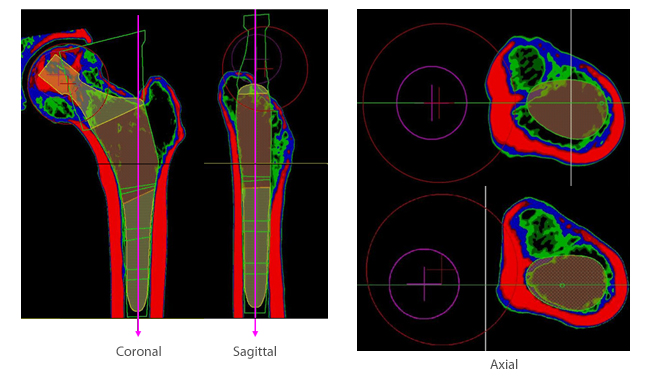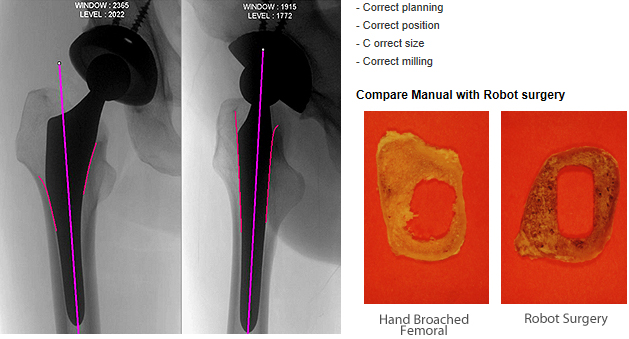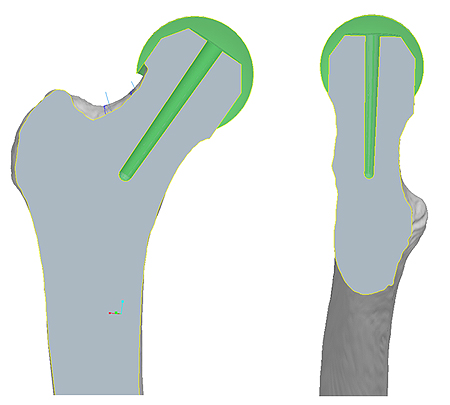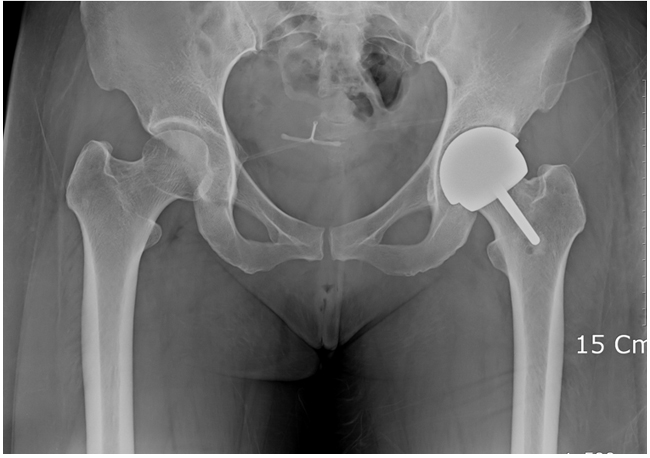
고관절수술치료

Robot THA
Procedure is usually performed under a general or spinal anesthesia. The procedure can be performed with the patient either lying on their side or on their back. The hip can be approached from the front, the back, or the side. After the hip is exposed, we use a surgical robot to precisely implement the presurgical plan. After the bone is registered using a novel non-invasive point collection mechanism, the neck of the femur is cut at a specific angle and the femoral head is removed.
This allows a good view into the hip socket. The arthritic hip socket often has lost its cartilage and has developed many bone spurs.
A device known as a reamer is used to prepare the hip socket for a metal cup by machining it to a hemispherical shape and exposing a bleeding surface of bone to allow in growth of bone onto the hip socket component (acetabular component).
Next, the component is impacted into place. Once the acetabular component has been applied, a second component or prosthesis is placed into the femoral shaft. This canel is prepared with a surgical robot to endure precise fit and fill and 98 percent bony surface to implant surface contact. This promotes bone in growth and therefore enhances the survival of the prosthesis. The femoral component is usually composed of titanium or cobalt-chromium alloy. Depending on the specific design, it can be implanted with bone cement or with direct contact to the bone (press-fit)
Pre-Operative Planning in Robot THA
| 3 Plane View Planning | |
|---|---|

|
|
Result
| Robodoc Surgery | |
|---|---|

|
|
Robot THA
- Possible to make a plan 0.1mm unit
- Alignment is possible to plan 3plane views
- Select best implant position in advance
- Select best implant size in advance
- Cut surface seems to be more even, not rough
- Alignment is possible to plan 3plane views
- Select best implant position in advance
- Select best implant size in advance
- Cut surface seems to be more even, not rough
Hip Resurfacing
Hip resurfacing is a form of arthroplasty which has been developed as an earlier intervention alternative to total hip replacement (THR). The potential advantages of hip resurfacing include less bone removal (bone preservation), a potentially lower number of hip dislocations due to a relatively larger femoral head size, and possibly easier revision surgery for a subsequent total hip replacement device because a surgeon will have more bone stock available to work with. The potential disadvantages of hip resurfacing are femoral neck fractures (rate of 0-4%), aseptic loosening, and metal wear. But we at Lee Chun Tek Hospital use a computer workstation and preoperatively plan the position and size of the best fit prosthesis customized to specific anatomy. Following this we rapid prototype a conforming piece of customized alignment jig that aids the surgeon to precisely align the cutting guides in surgery. With this new customized jig implementation technology it is seen that femoral neck fracture rate is a non- issue!
Patient suitability for hip resurfacing is decided by the patient's anatomy and the patient's doctor. Hip resurfacing is intended for younger patients who are not morbidly obese, are clinically qualified for a hip replacement (determined by the doctor), have been diagnosed with non-inflammatory degenerative joint disease, do not have an infection, and are not allergic to the metals used in the implant Hip resurfacing should not be used on patients who have severe bone loss in their femoral head, those with large femoral neck cysts present (typically found at surgery), or patients who have poor bone stock in the acetabulum. Caution should be used for patients who have rheumatoid arthritis, are tall, thin, or small bone, those with osteonecrosis (poor blood supply) to the femoral head, or those with femoral head cysts > 1 cm on an x-ray taken before surgery.
Patients with any of these conditions may not be suitable candidates for hip resurfacing. Come in for a CT scan and x ray to help us determine if you are a suitable candidate for this new customized placement procedure.
Patient suitability for hip resurfacing is decided by the patient's anatomy and the patient's doctor. Hip resurfacing is intended for younger patients who are not morbidly obese, are clinically qualified for a hip replacement (determined by the doctor), have been diagnosed with non-inflammatory degenerative joint disease, do not have an infection, and are not allergic to the metals used in the implant Hip resurfacing should not be used on patients who have severe bone loss in their femoral head, those with large femoral neck cysts present (typically found at surgery), or patients who have poor bone stock in the acetabulum. Caution should be used for patients who have rheumatoid arthritis, are tall, thin, or small bone, those with osteonecrosis (poor blood supply) to the femoral head, or those with femoral head cysts > 1 cm on an x-ray taken before surgery.
Patients with any of these conditions may not be suitable candidates for hip resurfacing. Come in for a CT scan and x ray to help us determine if you are a suitable candidate for this new customized placement procedure.
| Pre-Operative 3D surgical planning |
|---|

|
Result
| Result |
|---|

|
| Our results are consistent with our pre surgical planned position as you can see in the radiograph. Precise placement of the prosthesis reduces fracture rate and correctly size reduces rate of loosening. |


















